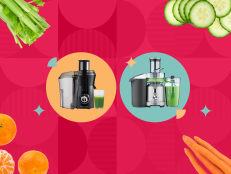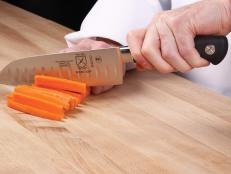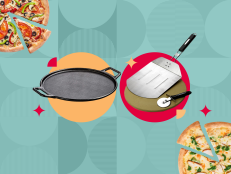5 Best Cheese Graters of 2024, Tested and Reviewed
We shredded — not to mention sliced, zested and ribboned — all manner of soft and hard cheeses, to find the greatest graters available!

Our Top Cheese Grater Picks
- Best Overall: Progressive International PrepWorks 7 Pc Grate, Slice, and Store Set
- Best Box Grater: Cuispro 6-Sided Box Grater
- Best Rotary: Cambam Rotary Grater
- Best Value: OXO Etched Box Grater With Removable Zester
- Best Ergonomics: KitchenAid Fresh Prep Slicer/Shredder Attachment
Tested by Jill Waldbieser for Food Network Kitchen
Recently, our tester’s cheese grater broke. She didn't rush right out and get a replacement and soon discovered how wrong that was. She found she uses a cheese grater almost as frequently as her kitchen knives. These are indispensable tools not only for cheese, but for shredding vegetables, chocolate, cheese, nuts, and even as a secret weapon for making perfect dough.
But when shopping for cheese graters, options abound: rotary graters, electric graters, ergonomic box graters of all kinds.
While a lot of it comes down to personal preference, there are some important considerations when choosing a cheese grater. You want to think about how you’ll be using it, how often, and for what kinds and quantities of cheese (or other ingredients). If your family enjoys homemade pizza with fresh mozzarella weekly, you’ll likely want a different tool than those who are looking for a finishing sprinkle of Parmesan over their pasta. This is also a notoriously difficult-to-clean kitchen tool, but some options are less messy than others.
How We Tested
To challenge each grater to its maximum capabilities, we tried three different types of cheese of varying hardness: a cheddar, Parmesan, and fresh mozzarella. We also added a test of a frozen stick of butter, because one of the main ways we like to use a grater in my kitchen is to grate butter for perfect flaky dough. It’s a trick we learned a long time ago and have relied on ever since, and butter is a good test because it starts hard but gradually softens as you grate, so you can witness the transition and how well a grater performs in real time (chocolate can be similar). We noted how comfortable each grater was to use, how much effort and time was required to grate each type of cheese, and how the finished product turned out in terms of texture, consistency, and appearance. We also cleaned each product, which can be notoriously difficult to do with graters (comedian Mitch Hedberg famously called them “sponge ruiners”).
Unlike most box graters, which are vertical, this set rests on a slightly angled plastic collecting container, so you grate in a horizontal motion that felt more comfortable to me, and allowed me to work faster. This set has fine and coarse stainless steel grating faces, as well as regular and julienne slicing faces. Each clips onto the base, making it easy to store when not in use. There is also a lid so you can grate a substantial amount (up to 2 cups) and store it in the same container. The coarse and fine grating faces both worked great on the Parm, cheddar, and cheese, and while mozzarella was a little messy, we were still able to get the job done. The removable grating faces are much easier to clean (and dishwasher safe), and there is a handy guard to protect your fingers from the blades. From a pure functionality standpoint, this set has everything you need in a basic grater.
This grater surprised us. At first we thought the hexagonal shape was just a gimmick, and that the metal seemed thinner and flimsier than other traditional box graters we tried. But it turned out to be the best for several reasons. The primary one was that it is exceedingly sharp, which is a huge asset for cutting through cheese of any hardness, and quickly. We appreciated the variety of grating options, particularly the very fine, hairlike grate for Parmesan cheese as a finishing touch to a dish. No other grater of any kind was able to achieve such a fine consistency. The hexagon shape also felt more ergonomic to me compared to rectangular box graters, which have handles mounted at 90-degree angles to the grating surface. Having a less severe angle made it more comfortable to hold, and without sacrificing much of the actual grating surface. The wider hex shape also allows you to access the inside of the grates more easily for cleaning. It rests easily on the built-in ginger grater but if you remove that, it has no non-skid grip surface to keep it from moving, but we didn’t find that to be a problem as the sharpness of the blades meant I didn’t need to apply as much pressure when grating. This is also why the metal can be thinner and the overall tool more lightweight, but not flimsy as we previously thought. We would say to be careful of your fingertips, though – there is no guard. Our biggest gripe with this grater is the packaging – the sticky protective tape used to cover the cutting surfaces was way too frustrating to remove before the initial use.
Most rotary graters are small handheld devices that have just about the max capacity for a family serving of Parmesan to garnish plates of pasta. In other words, you don’t get a lot without reloading. But this rotary grater works differently, more like a meat grinder. It has a suction base that secures it to your work surface, and then cheese goes in the top, optionally aided by a plastic food pusher, while you hand crank the grater wheel to churn out shreds of your desired size (there are three in the set). This option keeps your fingers safe, as the blades are completely covered, so it’s good if you are accident prone, and requires less effort than traditional box grating. This grater’s performance for hard cheeses and frozen butter was impressive — because it works so quickly, the butter doesn’t have time to soften. And it was considerably less messy to use on soft cheeses like mozzarella. The only drawbacks worth mentioning are that the suction base is not 100% foolproof, and you may struggle more with harder cheeses or ingredients. The actual shreds were not quite as precise or fine as some of the other options I tried either, but for most kitchen uses, this is a winner. It’s easy to assemble and disassemble for storage and cleaning, and seems sturdy, so although the brand is unknown to me, we’d expect this to hold up pretty well.
To be fair, most of the graters we tested were around the same price point, save the handheld rotary graters that can’t handle anything but the smallest amounts of cheese. So while there is no clear “budget” option, we selected OXO because the brand has a reputation for form and function, and this is a sturdy, all-purpose box grater with the added functionality of a zester cleverly built in so you get two kitchen tools for the price of one, both of which can be expected to last for years. The coarse and fine grating faces seem like the ideal sizes for most cheeses, and worked best for hard and medium cheeses (again, you can use this for fresh mozzarella, but there are better options). The OXO box grater has an ergonomic handle, modern design, and comes with a 1-cup capacity storage container with a lid that fits snugly onto the base of the grater so you can collect your ingredients and store them without a fuss. If you choose not to use the container, the base is sturdy and has a rubberized non-skid grip. Thai grater also has a somewhat narrow footprint, which is good for storage but can make cleaning the interior by hand difficult – but the OXO is dishwasher safe, so that may not be a concern.
This is a lovely option if you have a KitchenAid stand mixer and the budget for it. It is easily the lowest-effort way to shred and slice cheese, and works equally well on any kind of cheese as well as frozen butter. It attaches to a standard KitchenAid stand mixer and you can feed cheese through the top. The attachment comes with two different sizes of feeding tubes and three grating wheels (coarse, medium, and slicing), which can be changed out easily with the click of a lever. These parts are dishwasher-safe, which makes clean up easy. This is the future of grating: fast, easy, and doesn't require a lot of repetitive motion and strain. We also appreciate that the attachment is compact and doesn’t take up a lot of space to store. It won’t give you a finely grated cheese, but if you’re looking for shreds that could have come out of a store-bought package, this machine delivers.
Things to Consider Before Buying a Cheese Grater
Although a cheese grater isn’t going to be among the biggest investments you’ll make, it is a kitchen tool you’ll probably reach for often, so choosing a good one that suits your needs can save you a lot of day to day hassle.
It helps to think about how you’ll be using the grater most often: Do you eat more hard cheeses or soft ones? Do you plan to use a grater for other items, like shredding vegetables or grating chocolate for baking? For the most part, the box graters we tested performed better at hard cheese (and will handle things like carrots and zucchini well) while some other styles worked better for mozzarella. So if pizza-making is a regular thing in your home, that’s an important consideration to factor into your decision.
The size of the shreds can affect the texture of a dish as well. Most of the devices we tested had multiple options but not the same options: some had extremely fine grating surfaces (nice for a dusting of Parmesan) while others had slicers. Think about what functions you’re most likely to use. You’ll want to consider capacity as well. If you regularly cook for a large family (or are simply a cheese fanatic) you’re going to get frustrated with a rotary grater that only holds an ounce or two at a time.
Kitchens can be tough on graters, so finding one that’s durable and comfortable to use is also key. High-grade stainless steel blades will resist rust and stay sharp over time. Most of the graters tested were ergonomic in some fashion, but a comfortable grip can mean different things for different people, so if you can, try before you buy. Grating does require some elbow grease, so if you’re not up to that, have a condition such as arthritis, or just want to shred large amounts quickly, an option with some mechanical assist, like the KitchenAid shredder attachment, may be your best bet.
You can also consider the size of the grater and its aesthetic appeal if you’re short on storage space or plan to have it sitting out on a counter often.
How to Clean a Cheese Grater
How to clean a cheese grater is one of the eternal kitchen quandaries, as these tools famously shred any sponge that comes near them. Many claim to be dishwasher safe, but we found the easiest way to clean a grater of any kind is with a stiff-bristled kitchen brush, some dish detergent, and water. Start by tapping the grater to knock any loose shreds off it. Take it to the sink and add soap: We like Dawn spray dish detergent because it evenly coats the cutting surfaces. Then brush in quick, short strokes with the bristled brush under cool running water (use hot and you risk melting the remaining shreds and making them more difficult to remove). This technique works just as well even if your grater was used for something other than cheese.
What’s the Difference Between a Zester and a Grater?
Although similar, zesters and graters are not the same and we need one of each in our kitchen. While graters come with shredding holes of various sizes, they ultimately produce shreds or thin strips of food like cheese, chocolate, or vegetables. Zesters, as the name implies, are primarily used for citrus zest, although I also use mine for ginger, spices like nutmeg, and as a hack for never having to mince garlic again. Zesters tend to have much smaller holes and produce shavings much finer than a grater. They are also thinner than a grater because usually, you aren't zesting large amounts.
Related Links:































































